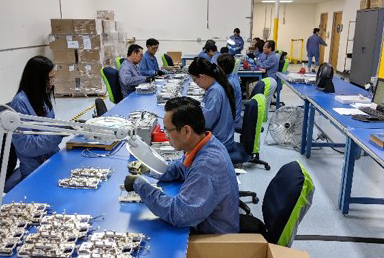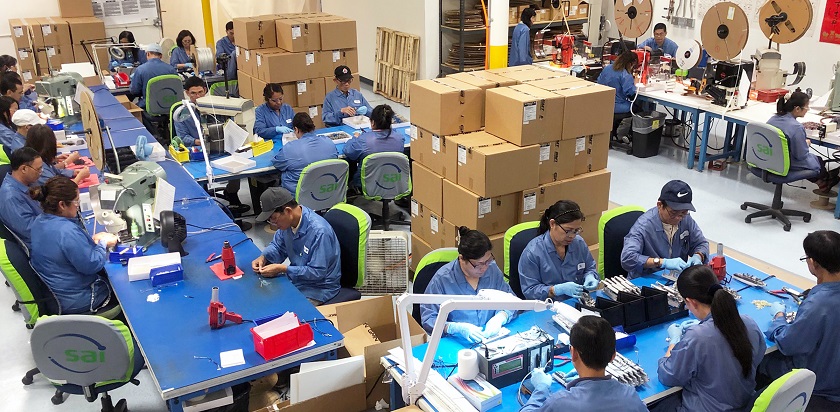Evolving Production from Job Shop to One-Piece Flow
How a PICK analysis helped cut EMS staff by 19% and raise production output 24%.
One challenge for smaller EMS providers is evolving from a job shop model focused on expeditiously completing small runs to optimizing processes in higher-volume production projects. In many cases, the facility’s ability to be flexible and do both types of projects is a business advantage. However, the focus on speed often reduces the focus on process optimization. For Spectrum Assembly Inc., flexibility combined with the ability to assemble cables, PCBAs and systems under one roof has been its biggest advantage. For the majority of projects, distributing workload among functional areas such as cable assembly, SMT and final assembly has represented the best division of labor since it put production near the automation required for each process. As the business has grown and skilled labor has become less available within its Carlsbad, CA, community, however, SAI’s engineering team decided to evaluate some processes to identify potential improvement opportunities.
The production engineering team tackled its first process improvement target on Jun. 10, doing a value stream map of the current state production flow, which identified the steps in the process, travel time and the number of people and workstations involved. As part of this analysis, the team shot video and conducted a time study of each assembly process; created a process flow spaghetti diagram; calculated capacity, Takt times and workload balance; and identified wastes, bottlenecks and improvement targets. The product chosen was a bezel unit with wires that is scheduled to ramp to 3,300 per day later this year.
The initial analysis found the product took 5.5 min. to build and traveled through 30,000 sq. ft. of production floor during its assembly process. From a Lean manufacturing perspective, this represented the wastes of excess transportation and excess movement. The assembly process involved 32 people building 1,800 units per day. This extended batch process flow also created a large amount of work-in-process (WIP), which drove long wait states at each machine and consumed unnecessary production floor space. Other identified areas for improvement included the opportunity to introduce fixtures and jigs to reduce assembly process variation, better balance assembly time vs. takt time, and implement a more visual system in terms of process flow.

FIGURE 1. "Before" photo showing the longer linear process, which also required more workers.
The next step was to design a future state value stream map that reduced travel time and headcount. The approach focused on analyzing gaps vs. proposed solutions utilizing a Lean Six Sigma tool known as a PICK (Possible, Implement, Challenge and Kill) chart. A PICK chart is a four-quadrant grid that helps visually segregate brainstormed solutions into four categories based on a horizontal scale of payoff/benefits and a vertical scale of ease of implementation. The four quadrants represent:
- Low payoff, easy to do – possible
- High payoff, easy to do – implement
- High payoff, hard to do – challenge
- Low payoff, hard to do – kill.
During the analysis phase, the team realized the bulk of the assembly time was associated with travel time. The solution was to design a one-piece flow “W”-shaped workcell feeding two assembly lines that reduced the distance the products traveled for various assembly operations. In the redesigned workcell, the product traveled through less than 5000 sq. ft. from wire cut and strip through packing. Headcount was reduced to 26 operators.
The new workcell was launched on Jun. 17. Assembly time per unit was reduced to less than 30 sec., and the workcell is now producing over 2,000 units per day, with fewer operators. Operators have been cross-trained on operations to ensure they have variety in repetitive operations to avoid repetitive stress injuries. But SAI’s team is not finished with planned improvements.

FIGURE 2. The redesigned "W"-shaped line cut assembly time and required manpower.
The team is now working with the manufacturer of its cable stripping equipment to develop a custom accessory blade that can cut through braided cable shielding. Automating that process should further increase the run rate and reduce headcount. Additional fixturing is being developed to minimize process variation and improve speed per operation. As customer volumes increase beyond the capacity of the first cell, additional cells will be added.
Cumulatively, the expected benefits of the process redesign are:
- A 19% reduction in headcount by shift
- A 24% increase in production output
- A 52.6% increase in productivity per operator
- A 98% reduction in WIP
- A 41.7% reduction in workstation tables utilized
- A 50% reduction in production areas utilized
- An 85.7% reduction in the number of subassembly operations.
The team is now looking at other subassemblies that may also benefit from a one-piece flow workcell approach.
The benefits of this process improvement effort include better resource utilization both in terms of facility space and personnel, plus faster throughput. Production efficiency can now easily be monitored visually. Additionally, SAI is growing and finding skilled production operators in a labor market with low unemployment challenging. Reducing headcount in one project frees skilled operators for deployment to new projects. The ability to support growth with redeployed skilled operators also contributes to increased quality, since skilled operators don’t have the learning curve issues found with entry-level personnel new to manufacturing.
is manufacturing engineering manager at Spectrum Assembly Inc. (saicorp.com); antoniof@saicorp.com.
Register now for PCB West, the leading conference and exhibition for printed circuit board design! Coming Sept. 9-12 to the Santa Clara Convention Center. pcbwest.com




